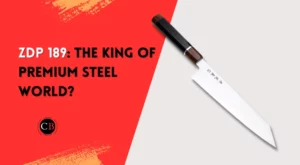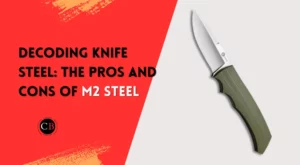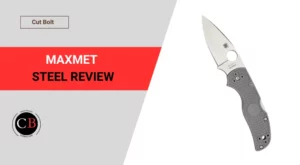With its incredibly high breaking strength, 65Mn steel is a popular choice for machetes and other tough tools where durability trumps sharpness. But how does this simple carbon steel perform for everyday knives?
In this 65Mn steel review, we’ll cover everything you need to know including composition, hardness, strengths, limitations, and proper care. You’ll learn how it compares to other popular knife steels and whether it deserves consideration beyond just bushcrafting blades.
By the end, you’ll be able to decide if 65Mn is suitable for your needs and discover the ideal knives and uses for this steel. Join us as we unpack the key performance factors and reveal who makes the best 65Mn knives. It’s time to become a steel expert!
Table of Contents
What is 65Mn steel?
65Mn is a low alloy carbon spring steel from Chinese production. 65Mn is used to make knives such as AK47 bayonets and machetes, as well as small section round and flat springs and watch springs. As it is a carbon steel, 65Mn is a tough steel, but as usual for low-alloy carbon steels, it has a lower corrosion resistance.
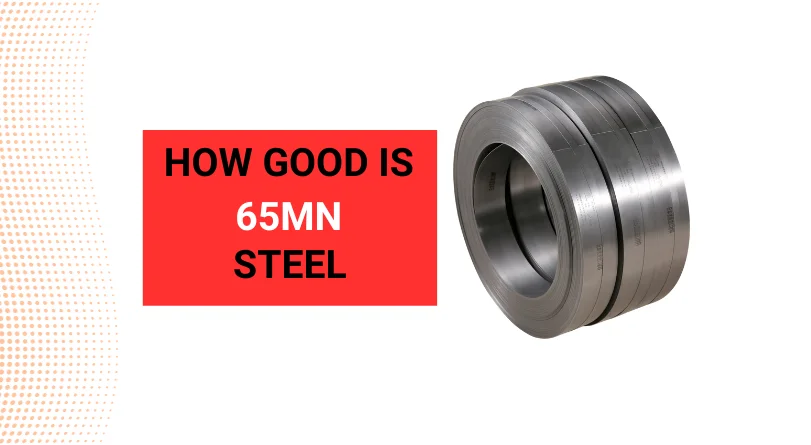
Other designations and standards of 65Mn steel
Most steels are known by other designations besides their popular designation. In the case of “GB 65Mn steel”, as its official Chinese standard designation, it is alternatively available under these designations:
- AISI 1066
- BS 080A67
- DIN 66Mn4
- DIN 67Ck
- GOST 65G
- PN 65G
- UNS G15660
65Mn steel chemical composition
| Element | Portion | Effect |
| Chrome | 0.20% | Improves wear resistance, heat resistance and scale resistance. It increases tensile strength because it acts as a carbide former. Use of rust-proof or stainless steel, as it increases corrosion resistance from a mass proportion of 12.2%. Reduction in weldability. |
| Carbon | 0.65% | Increasing hardness and tensile strength. In larger quantities, increase in brittleness and reduction in forgeability and weldability. |
| Manganese | 1.0% | Improves hardness and tensile strength. |
| Phosphorus | 0.4% | Increases tensile strength, hardness and corrosion resistance but also brittleness. |
| Sulfur | 0.5% | Increases machinability but also brittleness. |
| Silicon | 0.3% | Improves strength. |
This is the basic composition of 65Mn, but depending on the manufacturer it may also contain approx. 0.35% nickel and 0.25% copper.
What is the hardness (HRC) of 65Mn steel?
65Mn is not a dedicated knife steel, i.e. it is not produced exclusively for knives or optimized in its composition for use in knives. When hardened for knives, its hardness is 51-53 HRC.
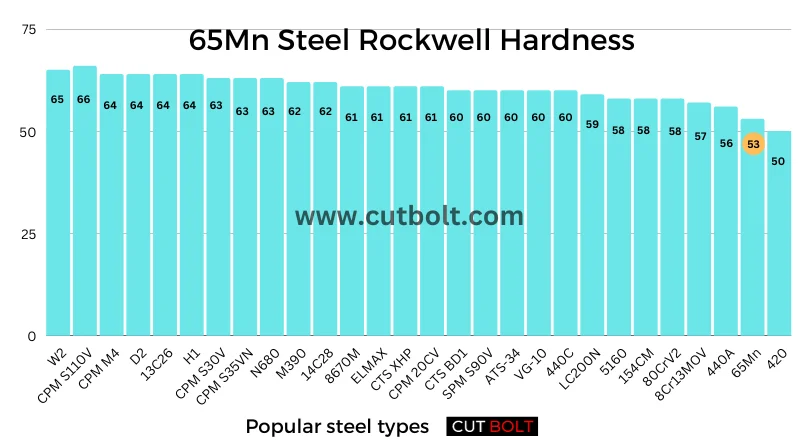
Is 65Mn stainless steel?
Stainless steel and rust-proof is not the same. To be considered stainless, the chromium content is crucial, for stainless steel the content of “impurities” by sulfur and phosphorus.
65Mn is neither a stainless steel nor a rust-proof steel. To be considered stainless, it would need a chromium content of at least 10.5 – 13% dissolved in austenite or ferrite, depending on the definition, and it is not a stainless steel because its sulfur and phosphorus content (so-called iron companion) exceeds 0.025%.
Properties of 65Mn steel
According to the chemical composition and hardness of 65Mn, this steel offers the following properties and characteristics:
- Edge retention: with a hardness of up to 53 HRC, this steel offers good cut resistance. Not the best but a good one.
- Corrosion resistance: Its corrosion resistance is far from good with only 0.2% chromium.
- Wear resistance: With 0.65% carbon, this steel offers good wear resistance.
- Sharpness: the rule is that the harder the steel, the harder it is to sharpen, with a hardness of 53 HRC, 65MN is not an extremely hard steel, which would then not be so easy to sharpen. In short, it can be sharpened well.
- Machinability: Since its hardness is well below 60 HRC, it is also good to grind and otherwise machine.
- Toughness: Its toughness is good, thanks to the mixture of carbon, chromium and manganese.
Is 65Mn a good knife steel?
The answer is a resounding YES. 65Mn steel would make a great knife steel. A 65Mn knife is a hard and tough knife. Such a knife would be a good choice for batoning, and as EDC.
However, due to the low corrosion resistance of this steel, it would be a poor choice if it is going to be used primarily in a damp to wet environment.
After all, who wants to be more concerned with knife maintenance than knife use?
That’s not the point. Hunters, anglers’ fishermen, divers and so on, but also cooks will definitely not be happy with it. These should preferably look around at knives with high chrome content. Starting with 420HC up to H1 and LC200N. Everything else is suboptimal here and therefore not recommended.
Related: CTS 204p steel review
65Mn steel equivalents
The most direct replacement for 65Mn steel is 1065 carbon steel in terms of composition, hardness, edge retention and durability. But depending on your needs, some of these other alloys can provide a comparable or improved experience.
Based purely on its properties, 1095 steel could also be an interesting alternative.
65Mn steel does not have an exact equivalent, but here are some comparable and replacement steels:
- 1065 Carbon Steel: Very similar simple carbon steel with 0.65% carbon content. Provides high hardness and edge retention.
- 1075 Carbon Steel: Another comparable plain carbon steel with 0.75% carbon. Slightly harder than 65Mn.
- 52100 Steel: This ball bearing steel has similar wear resistance and edge holding to 65Mn. Higher carbon content around 1%.
- AUS-8 Steel: Affordable stainless steel alternative. Lower carbon so not as hard but adds corrosion resistance.
- 420HC Steel: Budget stainless steel option. Can be hardened similarly to 65Mn but not as tough.
- 1095 Steel: Higher carbon version of 65Mn with greater hardness and edge retention, but more brittle.
- 5160 Steel: A spring steel with .60-.65% carbon. Tougher than 65Mn but less wear resistant.
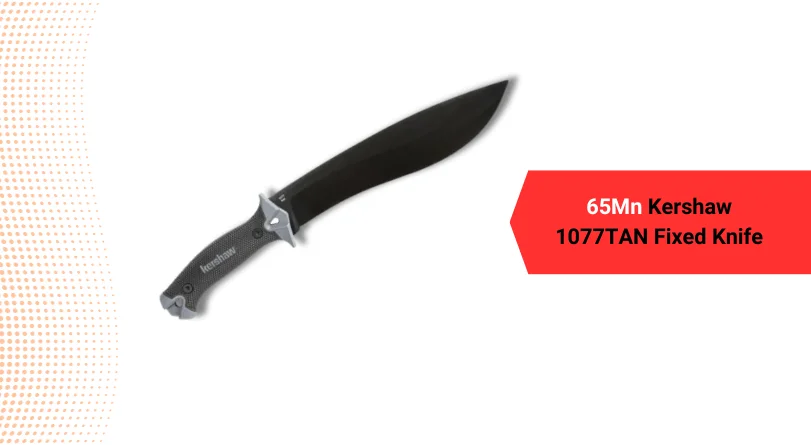
65Mn vs 1095 Steel
Let’s now compare 65Mn with a second steel with similar properties, 1095:
| Discipline | 65Mn | 1095 |
| Edge retention | 2/10 | 3/10 |
| Simplicity of sharpening | 9/10 | 7/10 |
| Corrosion resistance | 3/10 | 3/10 |
| Toughness | 8/10 | 8/10 |
As you can see, 1095 is very close to 65Mn steel in terms of toughness, corrosion resistance and edge retention, as well as both are easy to sharpen.
Conclusion: 65Mn Steel Review
For knife enthusiasts seeking a budget-friendly steel that prioritizes toughness and edge retention, 65Mn is a solid contender. This simple carbon steel delivers exceptional hardness and cutting ability, especially in larger blades designed for heavy tasks. While 65Mn may not have the corrosion resistance or stainlessness desired by some users, proper care and maintenance can help offset its vulnerability to moisture.
Ultimately, 65Mn’s merits come down to matching its characteristics with your needs and cutting environment. Those who value sheer durability per dollar spent will appreciate 65Mn’s rugged qualities. But wet conditions or corrosion risks may steer others towards slightly more advanced alloys. Either way, recognizing where 65Mn shines along with its limitations allows informed decisions about ideal applications.
At the end of the day, 65Mn brings a reasonable balance of hardness, edge retention, and affordability to the table. It serves as a viable option for anyone seeking capable cutting performance without breaking the bank, as long as they pair it with proper handling and care. And for large, tough blades meant for brute force over finesse, few steels beat 65Mn’s staunch ruggedness.

